
There is something enchanting about the idea of crafting something from scratch with one’s own hands – looking at a piece of dead wood and seeing something more and then breathing life into it again in the shape of a bow.
Hundreds of thousands of people have made their own bow from wood, and they all started somewhere. Whether you’re looking for a deeper connection to the sport of archery, trying to find your roots in hunting or you’re looking for your next challenge in woodworking; today, you can start here.
This build-along shows you how to craft a laminated flat-board longbow.
For this build-along we will be aiming at constructing a 45# at 28” hickory longbow.
Pro-Tip: Don’t be upset if your bow ends up pulling #20 at 28” – it happens more than you’d think. Being a bowyer takes practice and patience.
What you’ll need
- One 1-1/2″x1”x72” piece of hickory
- Optional Osage riser blank
- Hickory backing
- Optional phenolic tip overlays
- Unibond Wood Glue
- Clamps
- Sandpaper (from 60 grit on up to 300)
- Farrier’s Rasp
- Draw knife
- Band saw (optional, and can be completed without it, but this will make your life a whole lot easier)
- A round file
- Epoxy
- Tillering stick (sometimes called a tillering tree)
For this build-along we’ll be making a hickory longbow; although you might be more interested in making a recurve bow, that’s not a great place for a beginner to start. Hickory is not the only bow wood you can use; in fact you will find countless videos and tutorials online showing you how to make a self-bow from red oak, a cheap, brittle wood that is easy to come by and easy to break. However, hickory is, perhaps, the best wood for a beginner to start with because it can handle compression and tension better than red oak. Further, hickory has very good performance and speed and it will be a little easier for a beginner to tiller because the wood is a little softer than red oak.
Pro-Tip: Hickory is also great because it can be backed by its own wood. You can take a 1/8” strip of lumber off with a table saw and flip it end for end and reverse it, then glue this piece back on and you are good to go.
There are no specific schematics or a plan to print, but I’ll try my best to provide as detailed instructions as possible. However, you can learn more from our books and DVDs.
Making the Rough out Marks
Every piece of wood is different – for that reason, every bow is different, so there is no perfect guide or set of measurements, but hopefully these will help you along.
Find the middle of your bow stave (i.e. 36” would be the middle of a 72” bow).
Mark the middle. 
Mark 6” on either side of the middle – this will eventually become your handle. 
Mark 1” on the limb side of your 6” marks – these lines indicate where you will start your taper. 
To mark the center of your bow, measure up 3/4″ from the edge of the bow and put another mark perpendicularly on your middle mark. Now, you should have a + in the middle of your bow. 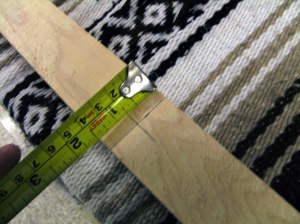
Take a string that is longer than your bow and run it across your bow. Attach a weight on either end; you might find it easiest to use squeeze claps. 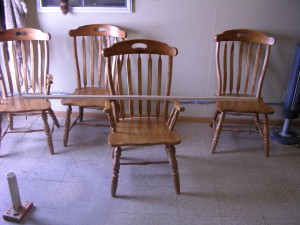
Move either end of the string on the tips of the bow until the string is resting as close to the middle of the ends of the bow as you possibly can, while ensuring the string is running straight through the center + of the bow. 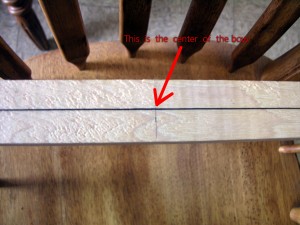
Make a mark on either end of the bow directly under the string. Connect the marks on each tip, running through the center + on your bow.
At either tip of the bow, mark 1/4″ on both sides of your center mark. 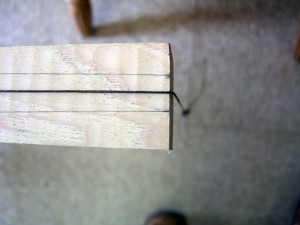
Connect each mark to their corresponding 1” mark.
This should make a taper from your handle to the end of your bow.
Next, starting from your 1” mark, draw a line to 3/8” above the tip of the bow (this will shape the belly of your bow). 
Let’s Get Cutting
- Wear safety glasses while cutting
- Never touch the blade while it is moving
Although a band saw is the best tool for the job, there are a number of hand tools that will also work such as your draw knife.
Remove the marked sections. 

Pro-Tip: A bow building vise, c-clamps, work bench or stave press all start to come in handy at this point.
Congratulations, you have the belly and the sides roughed out.
Rounding Out the Rough Edges
Make a mark on the side of both tips 1/4″ above the back of the bow. 
Draw a line connecting the points.
Using your rasp, round out the edge of the belly of your bow.
Pro-Tip: You may want to clamp down the bow, so you can use both hands during this process.
You will want to round the edges from the belly to the 1/4″ line that you drew earlier.
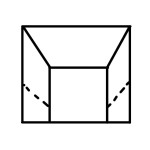
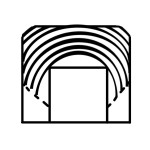
The goal is to make your bow go from the top image to the bottom image (looking down the bow).
OPTIONAL – Attaching the Riser
Although your hickory bow doesn’t necessarily need a riser, it can still be desirable to have. The riser (your handle) acts as a stop for each limb, which stops the flex from traveling through the middle of your bow. It is that travel, which will sometimes cause the phenomenon of a riser popping off of the bow. This is why there is a 1” buffer on either side of the riser and this is also why you add the riser before you start the tillering process. If you start the tiller before you add the riser the wood will “remember” flexing through the handle, which could cause your riser to pop off.
Feel free to play around with different kinds of wood for the riser (adding different colors and species of wood can really give your bow a custom, beautiful look). However for this build-along we’ll be using a 3/4″ x 1-1/2″ x 14″ Osage bow handle blank.
Make a mark indicating the middle of your bow on the side of your handle. 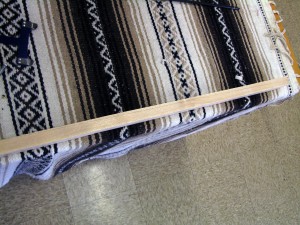
Make a mark on the side of your riser indicating the middle of the riser. 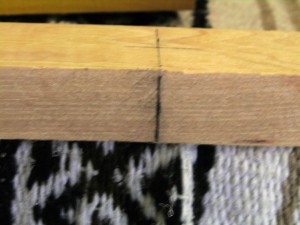
Align the two marks.
Glue your riser to the handle (on the belly side) of your bow.
Be sure to use plenty of wood glue (I recommend using EA-40 because it has more longevity than regular wood glue) – making sure to glue both surfaces, this will ensure you don’t have any dry surfaces.
Pro-Tip: You might want to put a piece of wax paper under your work area to avoid making a big mess.
Clamp the riser down with c-clamps.
Pro-Tip: Put a cloth or another piece of scrap wood between the back of your bow and the c-clamp to avoid scarring the wood.
Glue will ooze out everywhere, but that’s why we put wax paper down. This whole process can prove to be a little bit tricky, as the riser will try and move while you’re attempting to clamp it down. This will lead to a kind of twist-and-correct action on your part, but it’s not impossible.
Pro-Tip: This would be a great time for a second pair of hands.
After gluing on your riser, take the phenolic tip overlays (you also have the option of using wood of differing thicknesses, and using different species of wood to give your bow a nicer look) and epoxy them to the tips (making sure to apply epoxy to both surfaces) – on the back of your bow. 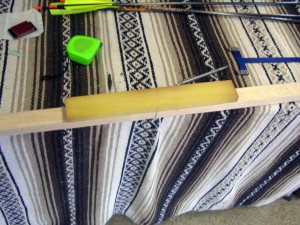
Pro-Tip: For a more traditional look, you can always use horn nocks.
Just like the riser, clamp down the tips with c-clamps.
After you’ve glued and clamped everything down it’s time to walk away.
After you’ve waited for at least 24 hours, remove the clamps and prepare to remove the excess wood on the riser and at the tips of the bow.
Be sure to avoid cutting into the belly of the bow when cutting the riser
Mark roughly 2-1/2″ back on either end of your riser. 
On the side of your riser, from the mark you just made draw a line in a crescent shape to the belly of the bow. 
Remove the marked section, blending the riser into the limb of your bow. 
You can use a band saw to remove this section, but it would be safer to use a rasp file.
Pro-Tip: If you’re going to use a file, clamp the bow down. By clamping the bow, you will be able to use both hands to remove excess wood.
We’re going to leave the sides of the riser squared off for now, so it will sit flat in the tillering stick later.
Backing the Bow
Although there are a number of different materials that can be used to back a bow, for our purposes, we will be backing the bow with hickory and EA-40.
Although there are many materials you can choose to back your self-bow (such as fiberglass, snake skin, bamboo, rawhide, sinew, and even cotton) for this bow hickory will give you the most longevity and protection from breaking.
Pro-Tip: You might be thinking that you don’t need to back your bow, and you might be right, but you’re probably wrong. Think of a toothpick. What happens when you bend a toothpick? One side, the back, will splinter and break. Your bow is like a giant toothpick, the backing will help to prevent your bow from splintering and cracking, which is why you back your bow before you tiller your bow.
Again, it might be a good idea to put some wax paper down to keep your workspace clean.
Apply a thin layer of EA-40 Bow Glue onto the back of the bow.
Apply a strip of hickory on the back of the bow that runs the length of the bow.
Clamp the backing to the bow with c-clamps.
Let the Smooth-On EA-40 Bow Glue dry for at least 24 hours.
After 24 hours, gently sand the hickory to knock off any burrs or excess Smooth-On EA-40 Bow Glue.
Use your draw knife or a band saw to remove any excess hickory that might be hanging off the sides of your bow.
Be sure not to cut your bow, just the excess backing.
Use sandpaper to smooth out the sides of the bow.
Adding the Rough Nocks
Draw a line 1” from the tip – making the bow 70” from nock to nock.
Using your file, cut a notch where the line is marked on the back of the bow (where you glued the tip overlay earlier). 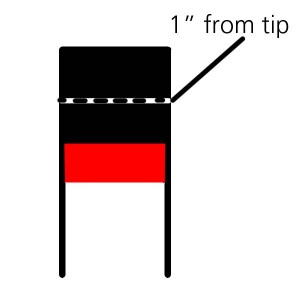
Next, using your file cut another notch on the side of the bow at about a 45 degree angle. 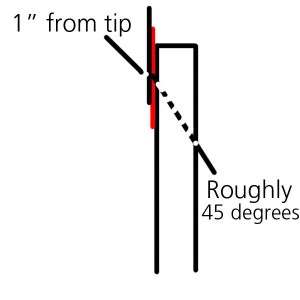
Work the file so that you don’t have any sharp edges and that both sides match each other.
Don’t cut the nock so deep that you can’t make adjustments later, but be sure to cut it deep enough that it will hold onto the string securely.
Time to Tiller the Bow
Successfully tillering a bow takes time and is difficult to teach, even in person, so there is only so much that you can learn from reading without just going and doing it. That said, be prepared to break a few bows.



Pro-tip: Never pull the bow past your desired weight. This means that if, after you first string the bow, you pull 45# at the first notch on the tiller stick then you need to stop and achieve a good tiller. After you’ve gotten a good tiller, repeat the process, if you are still pulling to the same notch, then cautiously remove some more material from the bow. Once you can successfully pull the bow to another notch at 45#, re-tiller the bow. Continue this process until you’ve achieved your ideal draw length.
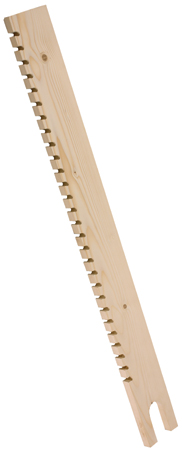
For this bit, you will need to either construct or buy a tillering stick and a tillering rope. 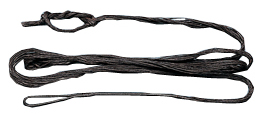
The tillering stick allows you to draw the bow to different lengths, stand back and examine the limbs to see how you need to work the bow.
Pro-tip: Your tillering rope needs to be long enough that you can put it on the bow and still have plenty of slack.
Pro-tip: If you don’t have a bow scale (and if you’re following along with this build-along, I’m guessing you don’t) it’s a smart idea to put a bathroom scale under your tillering stick. This way, when you pull down on the string you can see what poundage the bow is pulling. Just remember to either zero out your scale with the tillering stick on it, or subtract the weight of the tillering stick from the weight you’re pulling to get the actual weight of the draw.
You’ll start the tillering process by pulling down just a few inches
Longbows generally are never braced lower than six inches and many modern longbows like to be braced at or around seven inches. Your brace height is the distance between the string and the belly of the bow. Brace height is determined from the deepest portion of the grip. However, you can measure your brace height from whatever point on the bow you wish, back to the string. Some folks measure from the middle of the sight window, some from the belly side of the arrow shelf, and some from the deepest portion of the grip. If you’re discussing brace height with someone, make sure you’re both on the same page. Regardless of where you measure from, brace height is a critical measurement for tuning your longbow or recurve. For measuring brace height, nothing beats a T-Square.
Some things to remember when tillering:
- When tillering, you will want to avoid the hinges and remove wood from stiff areas, so the bow bends equally
- Whenever you remove wood from one place on a limb remember to blend it with the rest of the limb
- After you’ve worked one limb be sure to equally work the entire other limb, so that both limbs are even
- Move slowly – one inch down the tillering stick at a time
- More flaws will show up the farther you bend the bow, so if you pull the bow and see a flaw, stop and fix it
- Your standard tiller process will look something like this:
- Brace the bow on the tillering stick; you should not go to full brace starting off, keep it low, 2-3”
- Exercise the limb 30-50 times by pulling the bow to where it is currently braced and then relaxing it
- Place the string on the desired notch and level the bow
- Step back and evaluate the limbs for areas that need to be worked
- Mark the area that needs to be worked with a pencil and unbrace the bow
- Bring the bow to your work area and clamp it down
- Use a block sander or a scrapper to remove stock from the wood
- Remember to remove only a little wood at a time, as even removing a small amount can make a big difference
- Repeat until you have your desired tiller
- Whenever you remove any wood from the belly, you should exercise the limbs at least 30-50 times
Pro-tip: Count your strokes and mirror the number on the other side – especially when you’re simply reducing the weight of the bow and not fixing any flaws.
Pro-tip: At times, you might want to flip your bow around. This will help give you a fresh perspective on the project.
Remember, we’re shooting for a 45# at 28” bow, which means you should never pull the bow beyond that 45# threshold – you don’t want to put unnecessary stress on the bow.
You should set several milestones for yourself during the tillering process. Remembering that tillering is more of an art than an exact science, the first of those milestones should be something like 30# at 20.”
When you first string the bow with your tiller rope you will have a lot of excess. Pull down on that excess and see how far down it is when the limbs just start to bend. What ever the distance and weight, double it and that will be your first target milestone.
By taking a slower, more conservative approach to the tillering process you’re giving your bow the best chance of avoiding a break.
After you reach your first milestone you will want to string your bow at half-brace.
Now, you will want to pull the bow to 30# again and check how far you’re pulling , since you’re half braced you can expect it to be less than 20.”
At this point you might want to use a 2x4x4 and slide it along your bow to find stiff spots you couldn’t normally catch with the naked eye. 
There will be a gap between the block and the curve of the bow. On a perfectly tillered bow, as you slide the block down the limb the gap will stay the same. If, however, the gap gets bigger and then smaller it means that you have found yourself a hinge. If the gap does the opposite, gets smaller and then bigger, you’ve found a flat spot.
At this point you will want to creep your way to about 40#, remembering to move one inch at a time and to take out any flaws as soon as you see them.
Don’t forget to exercise the limbs.
After you’ve achieved your second target, it’s time to move your bow to full brace.
At full brace check for flaws and correct them if necessary.
It’s also a good idea to check string alignment when you first enter full brace.
Again, moving slowly, one inch at a time, bring your bow to your desired weight and draw – for our purposes that would be 45# at 28.”
Pro-tip: You might want to leave the bow a little heavy (a pound or two) as the bow will weaken slightly as it breaks in.
After you’ve achieved your desired draw weight and length it’s time to check if you have a positive tiller. A positive tiller is when one limb bends more than the other limb. The limb that bends more is normally chosen to be the top limb.
To check for a positive tiller, measure from the end of the fade near where the riser and limb meet to the string on both sides.
If you’re top limb has a gap 1/8” bigger than the bottom limb, then you have a 1/8” positive tiller. Don’t feel bad if your positive tiller is closer to 1/4″ or even 1/2.”
Pro-tip: A positive tiller is not a requirement though, a zero tiller is good too, just not a negative tiller.
Time to cut the arrow rest
Draw a line on the handle (belly side) in the center, both horizontally and vertically (you should end up with an +).  Draw a line 1” up the bow from the center (vertical | ) mark (toward the top of your bow).
Draw a line 1” up the bow from the center (vertical | ) mark (toward the top of your bow).  Pro-Tip: You are not doing a cut-to center shelf, as this would be too much for a self-bow. It should be at least 1/8” away from the center of the bow. In fact, you could avoid cutting the shelf altogether and simply shoot off the knuckle.
Pro-Tip: You are not doing a cut-to center shelf, as this would be too much for a self-bow. It should be at least 1/8” away from the center of the bow. In fact, you could avoid cutting the shelf altogether and simply shoot off the knuckle.
Make a mark 1/4″ down from the horizontal (-) center line.  Connect those points to make a box.
Connect those points to make a box.  The corner of that box indicates the inside corner of your arrow rest.
The corner of that box indicates the inside corner of your arrow rest.  Draw a slopped line from the corner of the box to the corner of the handle.
Draw a slopped line from the corner of the box to the corner of the handle.  Cut out the marked section.
Cut out the marked section.  Pro-Tip: These images are for a right handed shooter; flip the images for a left handed shooter.
Pro-Tip: These images are for a right handed shooter; flip the images for a left handed shooter.
Using a rasp, round file and sandpaper, round off the arrow rest.
Currently your arrow rest should look something like this. 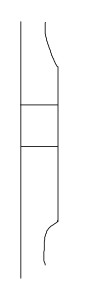 You want to round off the arrow rest until it looks something like this.
You want to round off the arrow rest until it looks something like this. 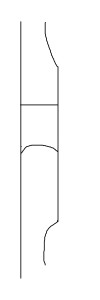 This will make it so the arrow will only rest in the middle of the ledge, which will cause less resistance and save some arrow fletchings.
This will make it so the arrow will only rest in the middle of the ledge, which will cause less resistance and save some arrow fletchings.


You will also want to use your round file to round out the inside corner of your arrow rest; currently it should look like the top image, you want it to look like the bottom image.
You might want to round-out and blend-in the remainder of your arrow rest, but that is purely up to you.
Shaping the Handle
Using your rasp start shaping the handle to look more like a pistol grip.
Pro-Tip: An easy way to do this is to simply hold the bow and see what feels like it should be shaved off; making sure it fits your grip.
Make the grip asymmetrical – that is, both sides should mirror each other (this is purely optional, but it helps give it that nice pistol grip shape) .
You don’t want to take too much off while shaping the handle.
After you’ve gotten the handle to feel right in your hand, use some sandpaper to take off the rough edges.
Start with a 60 grit and move up to a 220 grit – this will make your grip a delight to hold.
Rounding out the Nocks
Use your rasp and sandpaper to shape the nock into an inverted teardrop shape.
This is where the tip overlays we added start to come in useful; if you added different woods, your tips will really pop.
By making the tips of your bow a bit smaller it will speed up the bow and will also reduce hand shock.
There is no exact science to shaping the nocks, but you will want to be sure to maintain your good string edge.
Try and look online to see what others did.
Final sanding
The final sanding will smooth out the whole bow and take out any tooling marks that might still be around. It takes out any squared edges that are still visible and makes the whole bow smooth.
Be sure to sand the full belly of the bow to ensure consistency.
Don’t remove wood from the bow – you want to avoid tillering the bow at this point.
People start at different grits at this stage, but the higher the better – a 220 grit is a good idea to start with, but sanding with a 100 grit and then moving to a 220 grit is okay too.
The higher grit you go, the smoother your bow will be – consider working your way up to a 400 or 600 grit.
Finishing the bow
Clean the dust off with mineral oil
You have the option of staining the bow at this point, the color and kind of stain you get is all personal preference. You also have the option of simply clear coating your bow.
Many people also choose to paint the back of their bow:
- This process is simple and cheap
- Lay out some wax paper
- Use painter’s tape to cover the areas you don’t want painted, and spray paint the back of your bow whatever color you want
- After the paint has dried remove the painter’s tape
After you’ve stained and painted your bow, you will want to coat it (at least the belly) in polyurethane.
After the stain is dry, clean your bow with mineral oil
Lay out some wax paper and spray coat your bow in the polyurethane.
Wait 24 hours, gently sand the bow with 220 grit sandpaper and coat again.
Pro-Tip: You don’t have to wait the full 24 hours, but it’s a good idea if you’re going to give it that final sanding.
The final sanding is optional, but it will knock off any burrs that might have gotten stuck in the first coat of polyurethane.
Apply at least one more coat of polyurethane (some choose to coat their bow as many as five times).
Sign the bow with your name, date, draw length and weight.
Pro-Tip: You might want to sign your bow before your final coat of polyurethane to protect your markings.
Congratulations! You’ve built your first of many bows; feel free to customize your bow with a leather grip, arrow rest and plate, and whatever else you might fancy.
If you’re looking for something a little different with all of the tedious work already done, you should try one of our bow building kits.
By Jason D. Mills














.jpg)
